6. The Breakfast Club (1985)
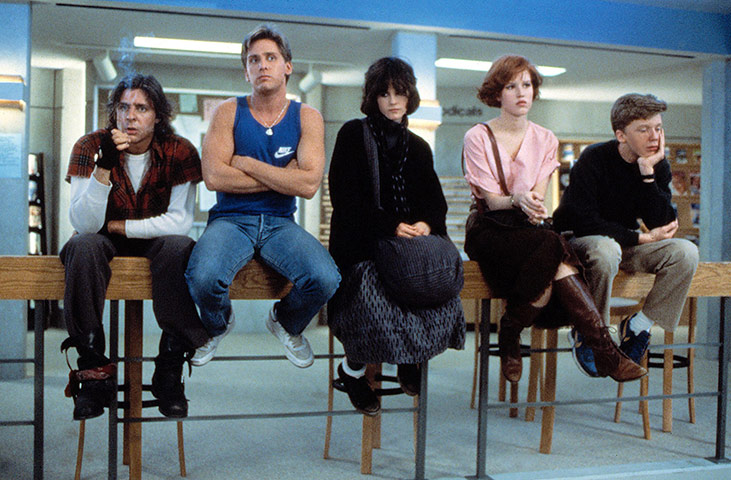
Standing somewhere above and outside the rest of the typical teen film medium is where you will find this 1984 John Hughes hit. What exactly the secret sauce was for this film is hard to pin down. The fact that it was fully written, directed, and produced by Hughes has something to do with it. Other contributing factors to its success and longevity are undoubtedly the fact that Molly Ringwald and Hughes always seemed to be just the right actor/director combination for what they were doing. The rest of the casting is essentially perfect as well, if there is another staple ingredient for early Hughes films beyond Molly Ringwald doing a great job of being Molly Ringwald, it’s definitely Anthony Michael Hall doing a great job of being nerdy and funny. To be fair, everybody fits their part precisely. Emilio Estevez is good and adds something to the two absolutely on fire performances by Judd Nelson and Ally Sheedy. Hughes seems to have known what he was looking for.
All these factors are part of it, sure, but what makes this film a definitive hit that adds to the youth culture canon is less easy to summarize. Decades after it was made it still enjoyed popularity, it was in regular rotation on cable through the 90’s and 00’s. It has been referenced, mocked, and imitated by many lesser entries in the teen film library. Kids watching it today still like it, and though its relatability for a teen audience has no doubt faded from where it once stood, it’s now seen as something of an 80s classic. Before that it was usually considered essential viewing for anybody born in the 1970-1990 range. That is a solid run for a 37 year old movie made on a million dollar budget, shot in one room, using high school Saturday detention as it’s foundation.
What makes it such an enduring piece of teen movie cinema? Maybe it’s the fact that the central idea was really good, a day in Saturday school detention with an odd mix of students. Many a typical white 1980s high school kid is given an avatar in this crew. All of these are still mostly recognizable and believable teens, and it still works. Maybe it was Hughes ability to have an ear for and actually recreate a certain kind of believable dialogue among his characters, including teenagers. The film would work as a play, dialogue, character development, and atmosphere are all center stage. So, is it the premise, the writing, the casting, or when it was made? It is probably all these things combining in just the right way.
Unlike other films on this list the movie isn’t particularly evocative of its time. Breakfast Club doesn’t rely on a lot of contemporary references, the kid’s outfits don’t scream 1980s, it just takes place in the 1980s. Its place in time might be most notable from the way it treats its subjects with a new seriousness and respect. This may well be another part of its staying power. John Hughes wrote and or directed some of the most well-known and remembered films that focus on American teenagers. Most of his output in this medium is from the mid 1980s, and all of it is worth a viewing, Hughes transitioned to comedy and family films in the early 90s and famously stopped working altogether ten years before his untimely passing. His work, of which “The Breakfast Club” is just one great example, upped the game on youth culture films.
7. Heathers (1989)
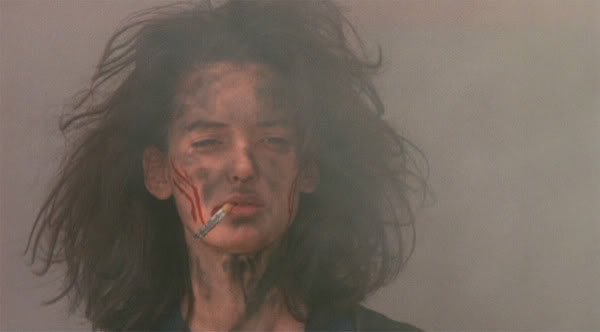
Now regarded as the definition of a sleeper hit, this dark comedy about girls who go beyond mean and get into savage territory, was not popular when it was released in 1989. Today it is a beloved and macabre little bit of nastiness. Although it has a good bit of 80s going on in the fashions and soundtrack, where it shines is in just going for it with a very dark plot.
Taking a deep dive in the completely awful dynamics of high school cliques, budding queen of weirdness Winona Ryder ends up going on what amounts to a killing spree. Teaming up with an early career Christian Slater who leans hard into his poor man’s Jack Nicholson schtick, they basically execute some of the most egregious “Chad” and “Karen” type characters in teen film. If it isn’t clear by this point, this is a very weird movie, but it knows it. Oddly the way the screen death unfolds is not reminiscent of a slasher film, but instead plays out as a series of deadly revenge games. Ultimately the psychotic J.D., played by Slater is responsible for most of the mayhem and eventually Ryder’s character Veronica has had enough. Look for a strange moment with J.D. and his dad and the memorable final scenes.
Although it’s uncomfortable to recognize, the idea of a pair of sweethearts going on a murder rampage is an absolutely real scenario that has played out more than once. Remember the juvenile delinquency issues worrying the cookie cutter society of the 1950s? Some of that was real, including when a leather jacket wearing greaser named Charles Starkweather, with his girlfriend along for the ride, killed 11 people in two months between 1957-58. That episode and more like it have been lifted for movie ideas several times. The idea of killer kids gone wild was once a common element in youth culture cinema. “Heathers” stands out because it twists this theme enough to make a movie that is surreal and absurd while still having a lot of evil chuckles. The movie relies on Winona Ryder and Slater to make it engaging and watchable even as it explores some real bad ideas. Making this movie today would have chances in the slim to none territory which is probably just fine.
A sequel was discussed as well as a tv series but neither have seen release yet owing at least in part to an issue of tone deafness in contemporary times. A movie like this, that blends extremely dark comedy with serious topics doesn’t need to be made again and it would be almost impossibly tricky to pull off. That said, between its release and the writing of this list, a few films have tapped into at least some of the black gold. Notably 1995s “Doom Generation” and 1999’s “Jawbreaker” both featuring celebrated performances from Rose McGowan. Given everything that has transpired with high school gun violence in the years since and the increased recognition and understanding around issues of teen suicide, projects like this, although influential and worth seeing, are probably better off as curiosities than staples of teen movies. “Heathers” is uncomfortable and so were a lot of the members of its audience, it seems to suggest a that the kids are not all right. That was true whether a relatively conservative 1989 America wanted to admit it or not.
8. Boyz n the Hood (1991)
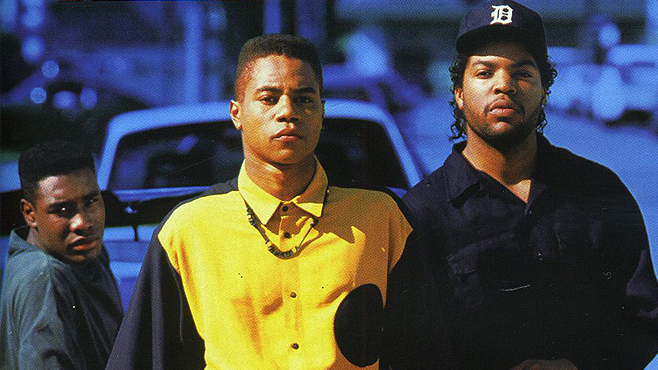
This film belongs on any list of youth culture films, films of the 90s, and any list talking about important movies made about America and the people living in it. Set in two time periods, the film lays its narrative groundwork in the 1980s with the characters as young kids. The films later half and dramatic climax is set against the backdrop of what was then a crime ridden but nevertheless vibrant and culturally resonant Crenshaw neighborhood in early 90s Los Angeles CA. That city in that time was one of several that was experiencing crime waves and socioeconomic strife that would lead to many consequences including future federal crime legislation that led to massive growth in the incarceration of young men of color. This movie draws a lot of power from another breakout ensemble cast driven by Cuba Gooding jr. and O’Shea Jackson sr. aka Ice Cube. The leads are assisted movie mainstay Laurence Fishburne and an up and coming Angela Bassett. It also represents the directorial debut of too soon departed director John Singleton.
Exploring complicated topics that are still difficult for the country, the film touches on structural inequality, issues in policing, education, and crime. Director Singleton brought these topics to American screens with his singular voice and vision. Part of the film’s vitality is that it does an excellent job of depicting the moment in time, but also for contemporary viewers creates an uncomfortable sense of how much has remained painfully the same. Scenes like the one where Laurence Fishburne’s character talks about the disintegration of urban neighborhoods, or when SAT scores are singular determinates of the future hit hard. Singleton would expand on these themes in other excellent entries like 1995’s “Higher Learning” and the 2001 film “Baby Boy”. For those inclined this would be a good starting place to explore the underrepresented aspects of Black America in youth culture films. Along with Singleton’s other films, Spike Lee’s famous “Do the Right Thing”, and Barry Jenkins 2016 Oscar winning “Moonlight”, are must see.
There are certainly other entries exploring American youth culture for people of color. Most are worth looking at and easily recommended, some of them veer into comedy and mixed genres. The films here are given to provide a counterweight to the elements of the suburban white middle class dominance of the other films on this list. None of them do this more effectively than Boyz n the Hood.
9. The Perks of Being a Wallflower (2012)
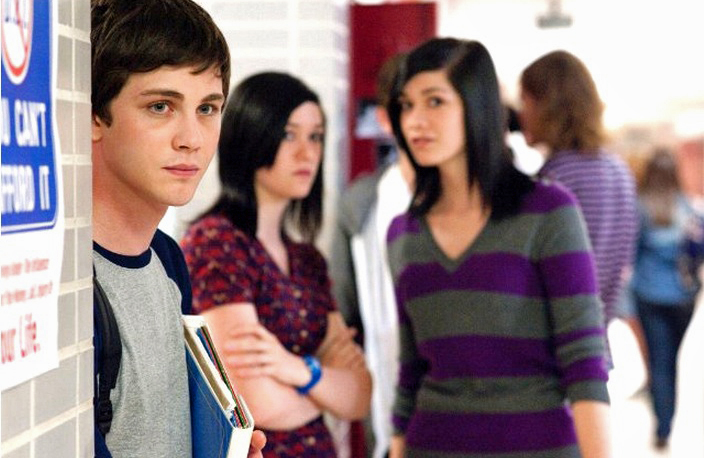
A film adaptation of Steven Chbosky’s book, the author turned to directing and getting it on the big screen. Chbosky held out on the rights until someone was willing to let him helm the film which certainly paid off for the audience. Set in the early 90s both the book and the film do what the other successful films on this list do. It taps perfectly into the moment where the story unfolds, the styles, the soundtrack, and the general vibe evoke a certain piece of the 1990s the way that people lived it.
This movie isn’t looking for laughs and doesn’t need to, it is an intimate exploration of experiences with an intelligent but troubled young man navigating high school. Successfully making friends with some older kids, the main character Charlie has a big year. The movie does a nuanced and realistic job of dealing with familiar but always significant topics. Charlie reveals and navigates mental health issues with his new friend group whether he want to or not. With respect to this particular part of the story, the film should be credited with its take. This is not an after school special and everything stays realistically messy but not hopeless.
The other main characters Sam, played well by Emma Watson, and Patrick provide the main character and audience with channels to use for Charlie’s growing up. He and Sam deal with a complicated romantic tension that will be familiar to anyone who had older female friends when they were in high school. In much the same way as it addresses other things, realistically and with an eye toward how life is really lived, the film examines the relationships and social issues that stem from the third primary character. Without any tokenism or forced signals of virtue, Charlie’s freind Patrick and his sexual orientation provide important inflection points for the story. Still challenging for many teens and adults today, being gay in the 1990s was not an easy experience. If you enjoyed the 90s tv show My So Called Life”, and really who didn’t right? Well, you will get into this movie.
Although it did well when it was released ten years ago this film seems to have been swallowed up by the steady firehose of content available to audiences today. If this kind of film is to your liking or if you want to watch something a little different, give it a shot. If you have a jones for some 90s nostalgia this film will deliver, but not in blunt way, just through hints in its tone, atmosphere, and definitely in the soundtrack. Writer/director Chbosky does not have a massive output, active most recently by directing the film version of the musical “Dear Evan Hansen”. His film version of his own book is a high quality late entry in the American youth culture section.
10. The Edge of Seventeen (2016)
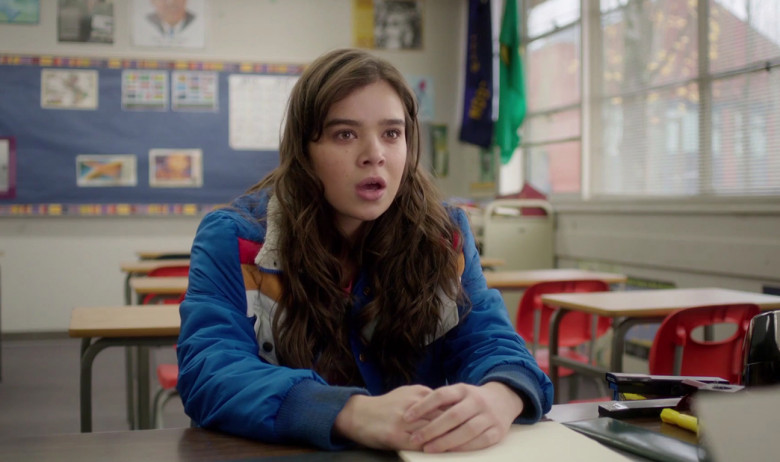
Hailee Steinfeld is a powerhouse and has been proving it in movies since her first big role in the Coen brothers take on “True Grit”. Edge of Seventeen is a good contemporary movie in this youth culture niche but the star’s ability to really bring it in her roles makes it more than that. The film isn’t talking about any earth-shattering material, but it does examine how lots of things are earth shattering for teens and young adults. This story is heavy on laughs but doesn’t resort to anything over the top like so many other of the more recent teen focused movies. One shot gags and mugging for the camera aren’t a big part of this movie. Instead, good writing and a solid cast alongside the main character provide layers of humor and humanity. The supporting players, like Woody Harrelson as a believable mid-career social studies teacher who likes his students but is not in love with his job, exceed expectations. Relatability is clear and present with the characters in this movie and a big part of why it works.
First time director Kelly Fremon Craig knew what she wanted to do with this movie and did it. Edge of Seventeen is a great example of how movies in the American youth culture genre still get made as well as why they can still be worth our time. Watching this movie, viewers familiar with teen films might feel some strong similarities to another director’s entry on the list. It’s evident that Edge of Seventeen has some very tangible John Hughes vibes. It’s a similar kind of honest and truthful film making from a director who was clearly willing to tap into what works about those films. This proves to be a positive as it almost an homage in some very good ways.
At this point the movie is only about 5 years old and it’s too soon to say, but it might serve to be a great example of teen life for the last decade. Given the elements that made it successful, both with box office audiences and critical reception, that isn’t a stretch. It’s early yet in the 2020’s and many things about life have been disrupted for America and everywhere else recently. What that means for US youth culture cinema remains to be seen, but this picture is for sure one of the better recent entries.